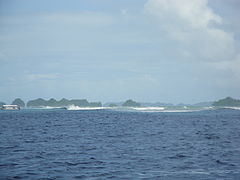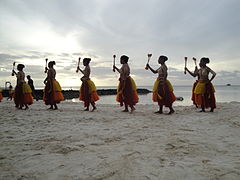Palau
![]()
This article needs a revision: See Discussion:Palau#QA / Revise needed or Revise building block; much of the data and info is already a decade to a decade and a half old.
Please help improve it, and then remove this tag.
![]()
The title of this article is ambiguous. For other meanings, see Palau (disambiguation).
Template:Infobox State/Maintenance/NAME-German
Palau ([ˈpaːlaʊ̯], full form Republic of Palau, pal.: Belau) is an island nation in the Pacific Ocean. Its population of about 19,000 (estimate, as of 2019) populates eleven of the state's 356 islands. The capital is Ngerulmud on Babeldaob Island; official languages are Palauan and English. Until independence on October 1, 1994, Palau was a UN Trust Territory under the administration of the United States. To this day, the state is associated with the USA and strongly influenced by the former colonial power; thus, Palau is a presidential republic based on the American model with 16 states as administrative units.
Geography
Geology
The state is assigned to the Pacific island region of Micronesia and includes the Palau Islands, which are formed from the western archipelago of the Caroline Islands and lie to the north of New Guinea, as well as some far-flung islands in the southwest (called the Southwest Islands). The six island groups of the Palau Islands consist of 356 islands, by far the largest of which is Babeldaob at 396 km². Only eleven of the islands are inhabited.
Originally, today's islands were a coral reef that was lifted out of the water by continental movements. Most of the islands are atolls of coral limestone, lying only a few meters above sea level and enclosed by a barrier reef.
The former capital Koror is located on the island of the same name, Koror, which covers only 11 km². In the east of the main island Babeldaob, the new capital Ngerulmud was built in 2006.
flora and fauna
Mainly due to tides, the base of many islands was hollowed out, creating today's typical mushroom shape. Many islands are under nature protection, which forbids a development and on some islands already the entering.
The underwater world of the region counts over 1500 species of fish and 700 species of corals and anemones. Palau is home to rare and endangered species such as dugongs, giant clams and saltwater crocodiles and rarities; for example, mastigias jellyfish have evolved into a non-toxic subspecies in isolation in the "Jellyfishlake".
Palau has 142 bird species, 16 of which are endemic, including the Palau owl, the Palau ground dove and the Palau fantail, as well as two endemic bat species (fruit bat). Of the approximately 1260 plant species, 109 are endemic, including wild orchids and the cicada palm.
In September 2003, then-President Tommy E. Remengesau Jr. signed a law protecting sharks in the waters around Palau, creating the world's first shark sanctuary.
Due to Palau's precarious situation, with only a few meters above sea level, its President Johnson Toribiong called on the UN General Assembly on September 22, 2011, to seek a legal opinion from the International Court of Justice in The Hague on the question of the responsibility of states for the consequences of ongoing climate change. A year later, there is debate about whether the Assembly should do so, and there is much to suggest that Palau's initiative could succeed.
Climate
The climate is tropical. The average annual temperature is 27 °C, the amount of precipitation per year is 3000 to 4000 mm.
| Palau | ||||||||||||||||||||||||||||||||||||||||||||||||
| Climate diagram | ||||||||||||||||||||||||||||||||||||||||||||||||
| ||||||||||||||||||||||||||||||||||||||||||||||||
| Monthly average temperatures and precipitation for Palau
Source: | |||||||||||||||||||||||||||||||||||||||||||||||||||||||||||||||||||||||||||||||||||||||||||||||||||||||||||||||||||||||||||||||||||||||||||||||||||||||||||||||||||||||||||||||||||||||||||||||||||||||||||||||
· 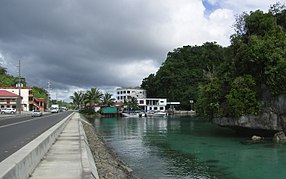
Typical changeable weather
·
Palau Outer Reef
· 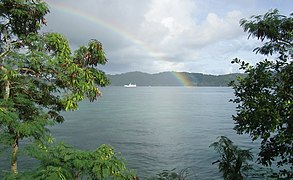
One of the frequent rainbows
· 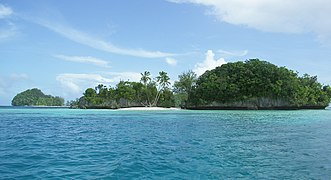
Chelbacheb Islands, nature reserve
Population
· .jpg)
Painted house on Palau, around 1910
·
Women doing a traditional dance
Development
| Year | Population |
| 1950 | 7.441 |
| 1960 | 9.642 |
| 1970 | 11.480 |
| 1980 | 12.194 |
| 1990 | 15.088 |
| 2000 | 19.129 |
| 2010 | 17.457 |
| 2015 | 17.661 |
Source: UN
Ethnic groups
The Palauans - Micronesians with Malay and Melanesian admixtures - are the titular nation and form the largest ethnic group with a share of 72.9% (as of 2015). Furthermore, the population consists of 21.6% Asians; 2% are Carolinians and 1.2% are of European origin.
Languages
Palauan and English are the official languages on Palau. Japanese, Sonsorolean and Tobian are also used as lingua franca.
Palauan, which has official status on most islands, is spoken by 77% of the population. English is spoken by just under 32% of the population. 11.7% speak Filipino, Chinese is spoken by 1.4% of the inhabitants. Carolinian is spoken by only 0.07% of the inhabitants.
Religion
According to the 2015 census, the population professes primarily Christianity: 45.3% Catholics, 26.4% Protestants, and 6.9% Seventh-day Adventists. Modekngei, a syncretic religion of Palau, is represented by 5.7%.
See also: Islam in Palau
Questions and Answers
Q: What is Palau?
A: Palau is an island nation in the Pacific Ocean.
Q: How far is Palau from the Philippines?
A: Palau is 300 miles (500 km) east of the Philippines.
Q: When did Palau gain its independence?
A: Palau gained its independence from United Nations trusteeship administration (administered by the United States of America) in 1994.
Q: What is the native name for Palau?
A: The native name for Palau is Belau.
Q: What is the capital city of Palau?
A: The capital city of Palau is Melekeok.
Q: When did Melekeok become the capital of Palau?
A: Melekeok became the capital of Palau on October 1, 2006.
Q: What is unique about Palau compared to other countries?
A: Palau is one of the world's youngest and smallest nations.
Search within the encyclopedia
